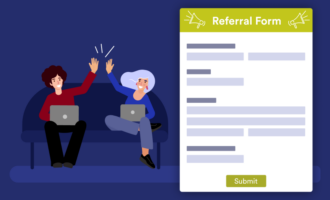A sales pipeline is a visual tool that helps teams better understand their deals in progress and what they need to do to close them. It illustrates the evolution of the brand-customer relationship over time through a series of stages.
Each stage includes an estimate of the likelihood a deal will eventually close. These estimates increase the further a deal travels through the pipeline. It’s a great tool to help sales professionals determine how to budget their time when nurturing potential clients.
Exactly what your sales pipeline will look like depends on your brand, industry, and goals. However, generally speaking, most sales pipelines include the following six deal stages in this order:
1. Leads
Before customers can buy your products or services, they have to know you exist. That’s why driving brand awareness is such a common goal for advertisers.
When your brand connects with new consumers — whether it’s a result of a digital marketing campaign, a content marketing effort, a webinar, or even word of mouth from a happy customer — you generate leads. This is the first big bucket that includes every possible consumer who might be interested in what you’re selling.
2. Lead qualification
Not every single lead will become a customer. You can attempt to win over all of your leads, but you risk wasting time and budget on uninterested consumers — and that’s time that would be better spent nurturing potential customers who are likely to purchase from your brand.
That’s why it’s important to separate consumers who are more likely to buy through a process known as qualification. Here, your sales reps tap into their arsenal of communication tools to analyze the big bucket of leads and determine which ones are both in your target demographic and have the budget for your products or services.
This smaller group of prospects have signaled they are in the market for your product — or they could likely be — so they are worth nurturing.
3. Sales demo
As your sales reps interact with a prospect, they gently nudge that potential customer toward a sale. At this early stage, it’s important to establish your brand’s reputation as a trustworthy thought leader in your industry. Once prospects have expressed interest in learning more, you can easily do this by offering content like white papers or webinars.
Follow up by scheduling a demo to give potential customers a more formal introduction to both your brand and products. This step is when the relationship starts to get more serious.
4. Proposal
If prospects like what they saw and heard in the demo, they’ll move on to the proposal stage. Like a marriage proposal, this is when two parties have had time to vet each other and are ready to decide whether they want to make things official or go their separate ways.
As the brand making this proposal, you’ll want to clearly state your case by reminding the prospect of how your brand — and your brand alone — can solve their problems, fulfill their needs, and perhaps even make their wildest dreams come true. (Remember, though: It would be unwise to overpromise and under-deliver.)
Think about what sets your brand apart from your competitors. Price? Quality? Value? Those are the themes you’ll want to highlight in this pitch.
5. Negotiation and commitment
She said yes! Or he said yes! Either way, it’s a deal. Now it’s time to draw up a contract — which may open up an opportunity for upselling before they sign on the dotted line.
Make sure you’re on the same page at this point in terms of the next steps, deliverables, and deadlines. You’ve made it this far — it would be a shame for the deal to fall through now because of a misunderstanding.
6. Opportunity won
Congratulations — you made the sale! Now it’s time to prove to your new customer that they made the right decision by following through on everything you promised — and delivering a best-in-class product or service.
But your relationship doesn’t end here. Instead, this is the point where you focus on turning that one-time customer into a loyal brand fan who will buy from you for years to come.
An alternate ending — opportunity lost
Uh-oh — this is the alternate final stage where you’ll end up if a prospect ultimately decides not to buy your products or services after all. The good news, however, is you can use sales pipeline analysis to determine why this prospect did not become a customer to help prevent this from happening again in the future.
And the cycle begins with new leads
This six-stage sales pipeline not only helps sales teams do their jobs better, but it also offers powerful insights for brands into how they can better interact with their customers and prospects. With this basic model and some sales pipeline analysis, brands can minimize lost sales — and maximize revenue.
Business photo created by yanalya – www.freepik.com











































































Send Comment: